OPENING
The center of my research for this project has always been visual novels. Danganronpa is the franchise in which my story is set in, but I also looked at other visual novels that I’ve read in order to learn from them. Each product will have a summary, proof of research and what I have taken from it. Tropes, themes, particular styles of writing, etc. The only exception to this will be the first topic – Danganronpa – as that warrants more in-depth analysis.
For the record, I have researched…
- Two video game / novel franchises.
- One movie, which serves as an influence for Danganronpa.
- One song, though there are several covers of it by different artists.
- Three different fields of study, ranging from hobbies to sciences. One is primary research. Two are secondary.
- Five members of the Danganronpa community (the ‘fandom’).
Were this a spectrum, I would admit that it leans towards more secondary than primary research. Despite that, the results were bountiful. I do not feel as if I have lost anything because of the secondary-focused research, and I have actually learned more than I would have if this were primary-focused.
DANGANRONPA
Danganronpa is a video game franchise both developed and set in Japan. Being the franchise that my story is set in, I knew much of my research would be focused on this and it’s inspirations. The setting revolves around Hope’s Peak Academy, a privileged school that scouts out and recruits a class of 16 students every year – each of whom are extremely talented in something and are referred to as ‘Ultimates’ or ‘Super High School Levels’. These talents can range from dancing, to sports, to science.
After being trapped in an isolated environment, the new class of students are met by the sadistic cartoon bear calling himself ‘Monokuma’. There, he forces the students to play a game. They can live in peace for the rest of their lives, never going to the outside world. Or, they can kill one of their classmates without being caught and escape. Each chapter involves a different murder, using motives as the catalysts. These motives can range from loved ones being threatened, to promises of fame and wealth.

(Cook, 2016)
Looking into this, I could see there was a wealth of information to take from the series – as well as the methods used by Danganronpa’s creator, Kazutaka Kodaka.
“We start building the scenario, characters and game system at once. At the beginning, we build the basic settings and then combine those three pieces to create a story. This is how we build the story that players can only experience with a game, but not with animation or novels.”
(Spencer, 2010)
“When creating the characters for Danganronpa, this is what I think about: How to turn the player’s expectations on its head. The reason I use very tropey characters is that this approach makes it easy to mislead players based on their expectations. And once you lead them as far as you want them to go, then suddenly pull them back, it makes that shock all the more impactful.”
(Mackey, 2015)
The two excerpts (and the interviews they stemmed from) were helpful for my creative process. By getting into the same method – or a similar method – as the creator, I could stay true to the story’s atmosphere. Colourful visuals with dark writing, using characters that have much more to them than meets the eye.
It was also a moment of enlightenment, because I knew that my methods were already similar – and that Kazutaka Kodaka is a writer who influences me. Knowing these two combined was – and still is – a boost in confidence.
So, as a person well-acquainted with the series (it’s been with me for three years now), I knew many of the tropes that Danganronpa sticks to and reuses. My story would not go past the first chapter – which, for context, is 1/6th of a 25+ hour game – meaning I could particularly focus on looking at the prologue.
Below is a glimpse into my observations regarding the prologue of the first game. I focused on character and pacing, as these are aspects of Kodaka’s writing that I feel, as a reader, he does best. To that end, I made notes about the story’s progression alongside an analysis of every major character.
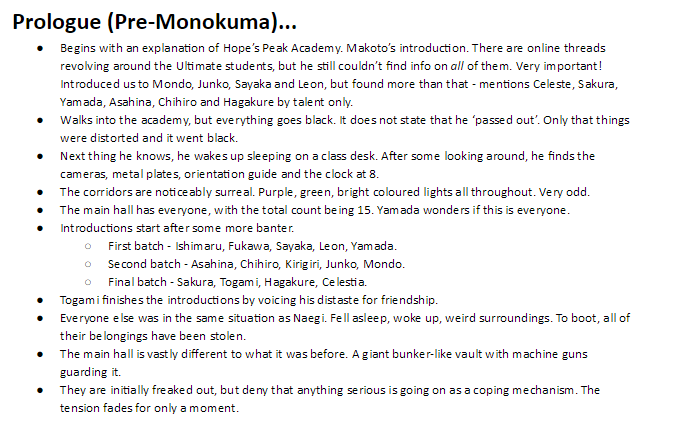 Character introductions were dished out in handful-sized chunks of 5 to 4 each. I would take this and use that same technique in my own story, because doing so in groups stops the reader from being overwhelmed. Having 5 character introductions at a time is far easier than having all of them to go through.
Character introductions were dished out in handful-sized chunks of 5 to 4 each. I would take this and use that same technique in my own story, because doing so in groups stops the reader from being overwhelmed. Having 5 character introductions at a time is far easier than having all of them to go through.
There are two key differences I would make, however. Both the first and second games began the story with an overview of Hope’s Peak Academy, the protagonist and their personality. However, this is merely info dumping, and provides a slow start.
The first difference is that the story starts abruptly. Miki – whose name we don’t even know yet – wakes up all of a sudden, in a place that is definitely not her bedroom. Her amnesia allows a more gradual stream of information. As well as this, the amnesia is foreshadowing. Why does she, in particular, have temporary amnesia? Did any of the others have it?
One key difference is that I introduce the deuteragonist* before everyone else. This sets him up as an ally for Miki, and means that there are only 14 introductions to go through later. This also shows that he, too, is suffering from amnesia. Unlike Miki, this seems to be more severe which contrasts with his happy-go-lucky persona.
*A deuteragonist is defined, by TV Tropes, as ‘Deuteragonist. The second guy. No, not the Sidekick, who follows the main character around. Not the Supporting Protagonist, who is the main character yet not the focus of the story. Not the Decoy Protagonist either. The second person the show revolves around.’ It also goes on to say that ‘an important aspect is that we see quite a bit of the story from this character’s point of view, and that they get a good amount of screen time/pages.’

References & Further Reading…
http://www.kotaku.co.uk/2016/09/19/a-beginners-guide-to-danganronpa
http://www.usgamer.net/articles/danganronpa-director-kazutaka-kodaka-on-the-power-of-psychopop
VIRTUE’S LAST REWARD
Virtue’s Last Reward is the second game in a trilogy known as the Zero Escape Series. The trilogy is known for a fixation on the number 9, diverse characters and a mixture of puzzle and reading elements (which are coined as ‘adventure’ and ‘novel’ modes respectively). This series was also developed by Spike Chunsoft, making it a sister series to Danganronpa.
I went into this knowing that I would be looking at examples of characterization, writing style and character interaction, elements that the Zero Escape Trilogy do exceptionally well and are what draw me into these stories.
As may be evident, characters are the key focus for VLR, with the story having more than enough time to explain their motivations, backstory and relationships with others.
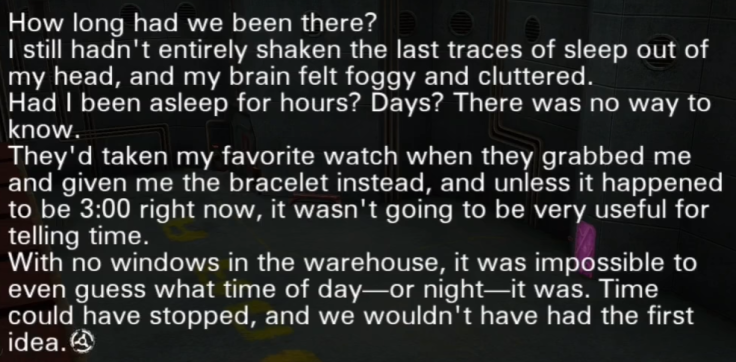
(58:22, video below.)
Despite being told in real time and not as a flashback, the protagonist’s inner thoughts were displayed in a past tense. This unique style is the same for my story.

(57:20, same video)
This style tells us, the reader, that the protagonist is also our narrator. He shows a real sense of confusion and wariness, while also peppering in some mild snark in ‘and unless it happened to be 3:00 right now, it wasn’t going to be very useful for telling time.’ His personality shines through inner monologues as much as it does through dialogue, allowing us to connect with him.
I wanted that same effect for my story, all the while twisting and shaping it so that it would be my own. In that way, I was on the right track.

As for character interaction and relationships, I could see this as well. The one I looked into was that of Tenmyoji and Quark. An old man around 60 years old and a small boy that was supposedly his grandson respectively. In many of the game’s routes (alternate timelines), Quark is put in danger through a virus or by disappearing. Because of this, Tenmyoji turns from a cynical stoic to a distressed father, immediately becoming one of the most emotional members of the cast.
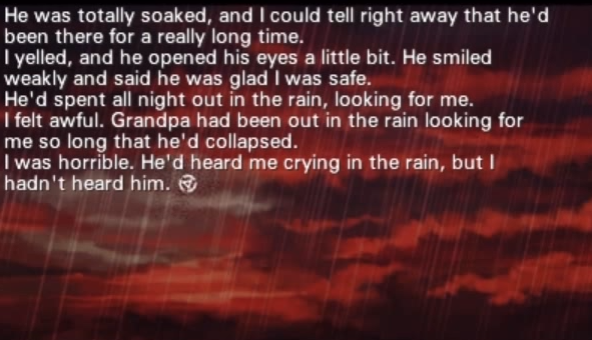
(15:37, video below.)
(Told from Quark’s perspective, not the protagonist’s. ‘Grandpa’ is Tenmyoji.)
From all of this, I learned to keep an eye out for character relationships and the writing style that VLR used for the inner thoughts. By making the protagonist a narrator as well, there is a bigger chance that my audience will be able to connect with them and better understand their personality.
References & Further Reading…
http://www.gamasutra.com/view/feature/184632/the_storytelling_secrets_of_.php
BATTLE ROYALE
I wished to examine the film, Battle Royale, as Danganronpa has been compared to it on more than one occasion in articles. A collection of Japanese high school students are placed onto an island and forced to kill each other, with the last person standing being the winner.
Unfortunately, early scenes and an examination of IMDB’s Parental Guide for the movie had revealed that I would not be able to stomach the sensitive content. Excessive live action gore is one thing that I am uncomfortable with, and the film is ripe with it. As such, I instead shifted focus to how much the creator was influenced by Battle Royale.
[Hardcore Gamer] Where did the inspiration come for the basic plot of the game?
[Kazutaka Kodaka] The original desire was to create a new IP, so delving into what I was interested in – Battle Royale and mystery novels. I thought, “what is a way I can combine these two things to create a new experience?”
(Hannley, 2015)
The game has a theme of “despair,” which is maybe not a theme you would expect from a game. Can you talk a little bit about how and why it approaches that theme?
YT: At first, the game, we didn’t naturally think about the theme of despair. But through the scenario, we mainly wanted to focus on a Battle Royale-style scenario — how people survive. But it became natural for us to consider having a theme that stood out, and that’s why we decided on the theme of hope and despair.
When you say “Battle Royale,” do you mean the book or the movie? Or just a general battle royale theme?
YT: I mean the movie Battle Royale. Our original idea was for a closed circle — which they often use in mystery novels. We wanted to do a setting where all the students would be trapped in one area.
(Nutt, 2014)
T-G: So some films, one for instance that was fairly popular here in the United States, Battle Royale, has a heavy allegorical theme offering an analysis of the life of Japanese students. Is there a theme that you would say runs through your games?
KK: My theme was similar to Battle Royale but I didn’t derive direct inspiration from it. I actually made the game based on high school students killing each other. Normally adults are more mature so I wanted to convey the story using high school students who are a little less mature and not fully developed. I used the story to portray their growth because as high school students they ‘aren’t complete yet.’ This eventually ended up becoming like a Battle Royale.
(Allen, 2015)
From this, I had a basic understanding of Battle Royale’s premise as well as how much Danganronpa was influenced by it. The amount of comparisons that the community and other articles made far outweighed the actual inspiration Kazutaka Kodaka got from Battle Royale. It was not designed to be a spiritual successor, and instead the story naturally came to be like Battle Royale. In that way, I learned that Kazutaka Kodaka was leaning more on writing a story he enjoyed himself. As he puts himself…
Schreier: Tell me about what it’s like to write a Danganronpa story. Do you start with the main mystery and then work from there? What’s your process like?
Kazutaka: Basically speaking, the story, the characters, and the gameplay are thought of, developed, and written concurrently. However, probably within that, the one that I pay the most attention to and give the most focus to is the characters, making sure they’re really well written and well done.
(Schreier, 2015)
References & Further Reading…
http://www.tech-gaming.com/qa-kazutaka-kodaka/
http://kotaku.com/a-brief-q-a-with-the-writer-of-danganronpa-1689628454
THE MAN WHO SOLD THE WORLD
The Man Who Sold The World is a song written by David Bowie and released on November 4th, 1970. It is the title track of his third album, and has been covered by various artists since then – notably by Nirvana, Lulu and Midge Ure.
I will be looking into the Midge Ure cover, which was a 1982 studio release. The song takes a much darker tone, with heavy use of piano and synthesizer. Midge Ure’s cover was also used as the title track of the 2015 video game, Metal Gear Solid V: The Phantom Pain.
The fact that this song is being used as inspiration started as a complete accident. I listen to music frequently while writing, and I landed onto the song through YouTube’s autoplay function. This happened to be while I was writing up characters, and ended up influencing the creation of Yukito Suguri. It’s darker musical tone, coupled with a singer who sounds gleeful, smart and in complete control of everything around him. Overall, the words are twisted to come from a very manipulative perspective.
We passed upon the stair
We spoke of was and when
Although I wasn’t there
He said I was his friend
Which came as some surprise
I spoke into his eyes
I thought you died alone
A long long time ago
(This sets up the story of two men. The singer meets someone who he knew. When this person says that he was his friend, the singer is surprised as he thought this person had died alone a long long time ago.)
Oh no, not me
I never lost control
You’re face to face
With the man who sold the world
(But this second person remarks that he never died, that he was always in control. Simply saying ‘you’re face to face’ makes him appear important. Being the ‘man who sold the world’ in the context of this darker tone sets him up as a much higher figure, a person of great importance.)
Yukito Suguri, one of my characters, was directly inspired by this song. Taking the words literally, with help from the cover’s darker tone, turned Yukito into an extremely manipulative person. He is introduced as a soft-spoken pushover, but I knew that a later chapter would reveal him as a cold, unfeeling businessman with a far more complicated past than what is initially expected. It is turning the ‘soft, tiny weakling with a pure heart’ trope onto it’s head.
TALENTS
Calligraphy
Kinjirou Sashihara is another character in my story, and is dubbed as the Ultimate Calligraphist. This stemmed from the desire to have a ‘traditional’ Japanese talent amongst the cast. The first game had a ‘Doujinshi’ (Fanfic Author in the localization), and the second game had a ‘Yakuza’ (a global criminal syndicate that originated in Japan). Thus, I looked into the art of Japanese calligraphy.
It is a traditional artform that is still popular today. Japancalligraphy defines it as…
Japanese calligraphy (Shodo) is one of the most popular fine arts of Japan. Calligraphical works are appreciated no less than products of painting. But this kind of the fine arts also possesses philosophical sense. In the simplest understanding, calligraphy is an art to write beautifully. The master creates a work of art by bamboo brush and inks on the rice paper. It transfers harmony and beauty. The parity of simple and graceful is embodied in calligraphical works as one of main principles of Japanese aesthetics wabi sabi.
(Art Work Design Kft., no date)
The page goes on further to say this.
There is nothing casual in Japanese calligraphy. The beginning, the direction, the form and the ending of lines, the balance between elements are important for each line and point, and even the empty space testifies about many things.
…
Japanese calligraphy is not only the beauty, but also the sense more complex frequently, than value of written by brush hieroglyph. Harmony and elegance of lines creates not only aesthetic pleasure but also transfers thousand-year wisdom. Each line is meaningful; each movement of calligrapher’s brush creates something fine.
(Art Work Design Kft., no date)
Kinjirou was shaped by this research. I did not originally have an idea for his character, but my knowledge of Japanese calligraphy and the sheer effort it takes gave me inspiration. I used this and crafted a person whose only goal was perfection.
He became analytical and critical of others, to the point of having few friends and an introverted lifestyle, but he was not inherently mean. The art and his heritage as the member of a powerful family defined him, which is all thanks to this research.
http://www.japancalligraphy.eu/
Occult
Occultism as a practice is summarized as…
Occultism is the study of occult or hidden wisdom (to the occultist, it is the study of “Truth”, a deeper truth that exists beneath the surface). It can involve such subjects as magic, astrology, spiritualism, extra-sensory perception and numerology. There is often a strong religious element to these studies and beliefs, and many occultists profess adherence to religions such as Gnosticism, Hermeticism, Satanism, Luciferianism, Thelema and Neopaganism.
(Mastin, 2009)
It is very broad field by this definition, and can take many shapes and forms. This, however, leads to it being misunderstood or perceived as ‘generic’.
Some religious denominations view the occult as being anything supernatural or paranormal which is not achieved by or through God, and is therefore considered the work of an opposing and malevolent entity, so that the word has negative connotations for many people.
(Mastin, 2009)
A final extract from the same description provides further insight into the methods and practices one may engage in.
Direct insight into, or perception of, the occult does not consist of access to physically measurable facts, but is arrived at through the mind or the spirit, requiring some element of mental, psychological or spiritual training. This often makes use of a “focus”, which may be a physical object, a ritualistic action (e.g. meditation or chanting), or a medium in which one becomes wholly immersed.
(Mastin, 2009)
All in all, this overview of the occult was incredibly useful. One of the characters, Reiko Rai, is dubbed as the Ultimate Occultist. I learned about this early on in my research, and the idea that ritualistic actions may be a key part of an occultist’s practice was perfect. Spiritualism, astrology and rituals are the center of Reiko’s practices, and I felt far more confident about her character having learned about this field in more detail.
It should be noted that Reiko is an odd character, even from her introduction. She is established as a ‘meta’ character. She is fully aware of the fourth wall (a term for the barrier between the reader and the story), speaks cryptically and seems to be aware of what is going on before anyone else does.
I did not need to focus on her backstory, because her personality and her deeds give the message that she does not need a backstory. Having one would actually hurt her character. She would talk about the extent of her talent and her vast knowledge of the occult, rather than shed any light on her past.
http://www.witchcraftandwitches.com/related_occultism.html
Fishing
I knew from the outset that fishing was a similar sport to swimming. It yielded enjoyment and there are championships revolving around them, but they also improve the human body as a form of exercise. That was my line of thinking when making Daisuke Wakamatsu, the Ultimate Fisherman. His buff, highly absurd physique coupled with a ‘macho man’ attitude was a perfect starting point. It’s something of a running gag to call him something different referring to his body, with examples being ‘human steamroller’, ‘the Pain Train’ and an ‘assortment of fridges’.
But how does fishing come into his life? How has it affected him? My research on the topic led me to Huffington Post, which wrote an article about the benefits of fishing.
While fishing itself isn’t necessarily going to get your heart rate up, many of the best fishing spots require a bit of paddling, biking or hiking to reach, all of which have proven cardiovascular benefits. “You can make your fishing excursion as physical as you want,” Janna Superstein, president of fly fishing company Superfly International Inc., tells The Huffington Post. She stresses, however, that you don’t need to be incredibly active to participate. “Even just getting out there, you’ll still get the benefits of the outdoors and maybe that’s the beginning of a new fit, healthy lifestyle,” she says.
(Wise, 2014)
I also found an article from The Telegraph, which lists several reasons on what people don’t tell you about fishing.
8. There’s more to fishing than catching fish
It helps of course, but if you only go fishing to catch fish, then you’re missing the point. Instead, go to be close to nature, to sit in one place – or several places – so quietly that you blend in with your surroundings. Study the habitat, work out where the fish are and then, if possible, get them to bite. If you fish well, you’ll probably catch a fish; and if you don’t catch one, you’ll still have the satisfaction of having fished well.
(Beattie, 2014)
How does this influence Daisuke? His excessively masculine behaviour and quirk for constantly yelling is part of a facade he puts on. He’s remarkably calm and patient, but puts on the mask so that his many younger siblings have a living legend to look up to. In a way, he’s trying to be what his father was to him.
Learning this tells me about Daisuke’s life as a fisher, how he grew to such an abnormal size (apart from anime/Danganronpa tropes) and what he’s learned from fishing.
http://www.huffingtonpost.com/2014/09/06/benefits-of-fishing_n_5754408.html
INTERVIEW
I made a small Google Forms questionnaire for 5 members of my community to answer. I made clear that they could answer as briefly or as long as they wanted. Warning for foul language, I didn’t impose any rules against that because I wanted answers to be as genuine and as ‘from the heart’ as possible.
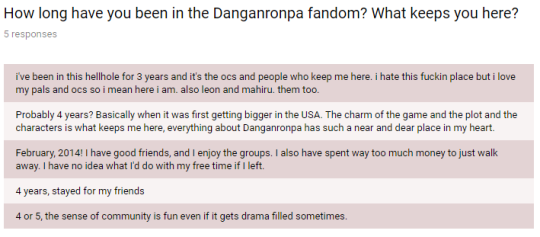
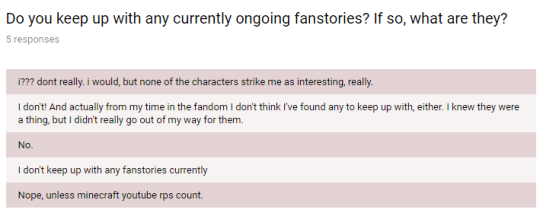
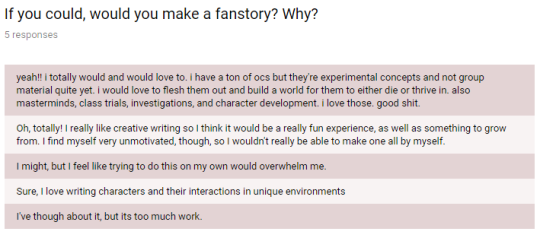

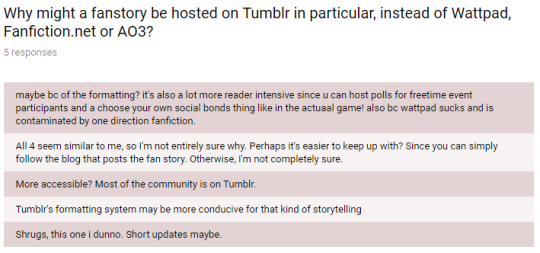
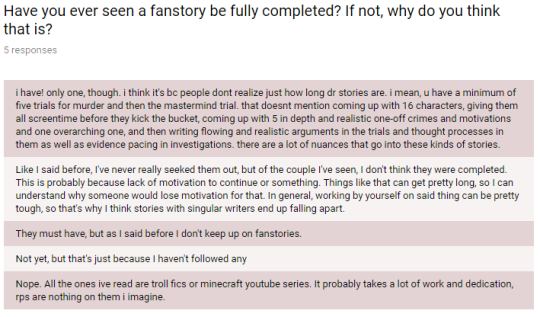

I interviewed one of these community members, a good friend who will go under the nickname ‘Kou’. We shared a conversation on Skype, the transcript is linked below and it was pretty informative! Alongside these questionnaire answers, I’ve learned that not many people are willing to make that step and create a fanstory due to limitations and the immense amount of work needed. It’s a huge undertaking. Being aware of this, I wasn’t discouraged. Many of the groups, fanstories and crowds that have formed in the Danganronpa fandom don’t finish their stories, but most of the fun comes out of experimenting with writing, developing new characters and making new friends!
It helps me understand the full requirements of this project further. You need art, you need writing skills, you need to flesh out 16 characters with several one-off murders and an overarching plot. Most of all, you need dedication and passion.
Bibilography
Cook, A. (2016) ‘A Beginner’s Guide to Danganronpa’, Kotaku, 19 September.
Available at: http://www.kotaku.co.uk/2016/09/19/a-beginners-guide-to-danganronpa
(Accessed: 6 May 2017)
Spencer. (2010) ‘Dangan-rompa Interview Discuses Character Design And Battle Royale’, Siliconera, 28 October.
Available at: http://www.siliconera.com/2010/10/28/dangan-rompa-interview-discuses-character-design-and-battle-royale/
(Accessed: 6 May 2017)
Mackey, B. (2015) ‘Danganronpa Director Kazutaka Kodaka on the Power of “Psychopop”‘, USGamer, 28 December.
Available at: http://www.usgamer.net/articles/danganronpa-director-kazutaka-kodaka-on-the-power-of-psychopop
(Accessed: 7 May 2017)
Nutt, C. (2013) ‘The Storytelling Secrets of Virtue’s Last Reward’, Gamasutra, 11 January.
Available at: http://www.gamasutra.com/view/feature/184632/the_storytelling_secrets_of_.php
(Accessed: 7 May 2017)
Spencer. (2013) ‘999 And Virtue’s Last Reward Creator Chats About Suspenseful Visual Novels’, Siliconera, 29 May.
Available at: http://www.siliconera.com/2013/05/29/999-and-virtues-last-reward-creator-chats-about-suspenseful-visual-novels/
(Accessed: 7 May 2017)
Drake, A. (2013) ‘DOWN THE RABBIT HOLE: THE NARRATIVE GENIUS OF VIRTUE’S LAST REWARD’, IGN, 22 April.
Available at: http://uk.ign.com/articles/2013/04/22/down-the-rabbit-hole-the-narrative-genius-of-virtues-last-reward
(Accessed: 7 May 2017)
Hannley, S. (2015) ‘Danganronpa Director Kazutaka Kodaka Opens Up On Plot Points, Future of Series’, Hardcore Gamer, 12 March.
Available at: http://www.hardcoregamer.com/2015/03/12/danganronpa-director-kazutaka-kodaka-opens-up-on-plot-points-future-of-series/137580/
(Accessed: 8 May 2017)
Nutt, C. (2014) ‘Dangan Ronpa: Death, stress, and standing out from the crowd’, Gamasutra, 20 February.
Available at: http://www.gamasutra.com/view/news/211205/Dangan_Ronpa_Death_stress_and_standing_out_from_the_crowd.php
(Accessed: 8 May 2017)
Allen, R. (2015) ‘AX: Q&A With Danganronpa’s Kodaka Kazutaka’, Tech Gaming, 2 July.
Available at: http://www.tech-gaming.com/qa-kazutaka-kodaka/
(Accessed: 9 May 2017)
Schreier, J. (2015) ‘A Brief Q&A With The Writer Of Danganronpa’, Kotaku, 3 May.
Available at: http://kotaku.com/a-brief-q-a-with-the-writer-of-danganronpa-1689628454
(Accessed: 9 May 2017)
Art Work Design Kft. (no date) Shodo – Art of Japanese calligraphy.
Available at: http://www.japancalligraphy.eu/
(Accessed: 14 May 2017)
Mastin, L. (2009) Occultism – Related Beliefs – Witchcraft.
Available at: http://www.witchcraftandwitches.com/related_occultism.html
(Accessed: 15 May 2017)
Beattie, R. (2014) ’10 things no one tells you before you take up fishing’, Telegraph, 20 June.
Available at: http://www.telegraph.co.uk/men/active/10870807/10-things-no-one-tells-you-before-you-take-up-fishing.html
(Accessed: 21 May 2017)
Wise, A. (2014) ‘How Fishing Makes You A Better Person (According To Science)’, Huffington Post, 6 September.
Available at: http://www.huffingtonpost.com/2014/09/06/benefits-of-fishing_n_5754408.html
(Accessed: 21 May 2017)
June 6, 2017 at 10:58 am
Prologue is very similar to a film beat sheet, often written as preparation for synopsis and then treatment.
This is an outstanding post that meets the criteria for research to a very high standard: detailed and evidence of the impact it will have on your on production.
LikeLike